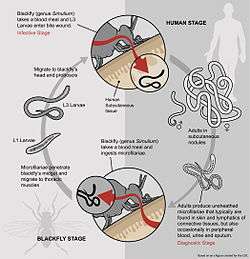Onchocerca volvulus
| Onchocerca volvulus | |
|---|---|
 | |
| O. volvulus, the causative agent of river blindness | |
| Scientific classification | |
| Kingdom: | Animalia |
| Phylum: | Nematoda |
| Class: | Secernentea |
| Order: | Spirurida |
| Family: | Onchocercidae |
| Genus: | Onchocerca |
| Species: | O. volvulus |
| Binomial name | |
| Onchocerca volvulus Bickel, 1982 | |
Onchocerca volvulus is a nematode that causes onchocerciasis or "river blindness" mostly in Africa. Long-term corneal inflammation, or keratitis, leads to thickening of the corneal stroma which ultimately leads to blindness. Humans are the only definitive host for O. volvulus. The intermediate host or vector is the black fly (Simulium).
O. volvulus, along with most filarial nematodes, share an endosymbiotic relationship with the bacterium Wolbachia. In the absence of Wolbachia, larval development of the O. volvulus is disrupted or ceased.

The life cycle of O. volvulus begins when a parasitised female black fly of the genus Simulium takes a blood meal. The microfilariae form of the parasite found in the dermis of the host is ingested by the black fly. Here the microfilariae then penetrates the gut and migrates to thoracic flight muscles of the black fly, entering its first larval phase (J1). After maturing into J2, the second larval phase, it migrates to the proboscis where it can be found in the saliva. Saliva containing stage three (J3S) O. volvulus larvae passes into the blood of the host. From here the larvae migrate to the subcutaneous tissue where they form nodules and then mature into adult worms over a period of six to twelve months. After maturation, the smaller adult males migrate from nodules to subcutaneous tissue where they mate with the larger adult females, which then produce between 1,000 and 3,000 microfilariae per day. The normal adult worm lifespan is up to fifteen years. The eggs mature internally to form stage one microfilariae, which are released from the female's body one at a time and remain in the subcutaneous tissue.

These stage one microfilariae are taken up by black flies upon a blood meal, in which they mature over the course of one to three weeks to stage three larvae, thereby completing the life cycle.
The normal microfilariae lifespan is 1–2 years; however, their presence in the bloodstream causes little or no immune response until death or degradation of the microfilariae or adult worms.
O. volvulus has been proposed as the causative agent of nodding syndrome, a condition that affects children aged 5 to 15 and is currently only observed in South Sudan, Tanzania and northern Uganda. Although the cause of the disease is unknown, O. volvulus is being increasingly studied as a possible cause due to its ubiquity in areas where the disease is found.[1] Nodding syndrome causes children to nod violently while eating; it has been described as an unusual form of epilepsy.
See also
References
- Saint André Av; Blackwell NM; Hall LR; et al. (March 2002). "The role of endosymbiotic Wolbachia bacteria in the pathogenesis of river blindness". Science. 295 (5561): 1892–5. doi:10.1126/science.1068732. PMID 11884755.
- ↑ Abraham, Curtis. "Mysterious nodding syndrome spreading through Uganda". New Scientist. Retrieved 2016-03-29.
External links
- "Onchocerca volvulus". NCBI Taxonomy Browser. 6282.